It might come as a surprise, but Manhattan has beaches. Yes, they’re small, often submerged at high tide, and you’d be crazy to go swimming in the water, but they’re still beaches. And there are more than you’d think.
I’m a huge fan of any property in Manhattan that goes unused or ignored, or at the very least has not been given a ceremonial name. Every inch of space on the island feels like it has been inspected countless times over to extract every last bit of value…and yet, somehow, certain pieces of land still manage to go forgotten. Among these are Manhattan’s assorted beaches, an interesting example of which can be found at 20th Street along the East River Bikeway.
Hey, it may not look like much, but it’s a beach, dammit! It even appears on Google maps as a pretty sizable portion of land:
This beach is actually not nameless, according to reader Rob – it’s known as Stuyvesant Cove (Rob also claims that the river’s pollution is much overstated, and invites us to join him for a swim in September!).
My favorite part about New York’s beaches are remnants from when they were actively used, and the 20th Street beach has a pretty great relic.
If you look in the above picture, you’ll see a large iron pipe. This is one of New York’s sewer system overflow pipes. When the sewer backs up during, say, a rain storm, these overflow pipes allow the excess sewage to go into the harbor. It sounds gross, but it certainly beats having it all come up your pipes into your toilets and sinks.
The pipe in itself isn’t that that special – there are over 450 along New York’s coast. However, if you follow it about 20 feet down to the water’s edge, you’ll find a really interesting relic from long ago: a pipe made of wood, which I can only assume originally connected to the mainland to transport sewage into the river.
As far as I can tell, wooden pipes are pretty rare. In Kate Ascher’s excellent book detailing the city’s infrustructure, The Works, she notes that the oldest pipes still in use in New York date back to 1851, and are made of brick, cement, and clay…but no mention is made of wood. Way, way back, logs would be literally carved out from end to end to serve as pipes, but those are all long gone. So I’m making the guess that this must at least predate 1851.
Here is the entrance – note the wooden support structure. The entire thing is partially encased in a crumbling mountain of concrete.
The pipe continues for about 12 feet or so…
…And finally ends amongst some old pier supports:
I’m not 100% sure this pipe would have connected with the visible overflow pipe. Beside it is what seems to have been another opening, now grated and deep below the sand. The sign above it gives a number to call in the event of an overflow during dry weather, though I doubt anything is coming out of this one. Could this have been the original exit for the wooden pipe?
I grew up on the coasts of Massachusetts, and I love finding random stuff on beaches. Would love to know how old this valve is…
Anyone have any further information? Am I completely wrong in my assumptions that this is not a typical pipe to be found in New York’s sewer system?
Regardless, Manhattan’s East 20th Street beach can be seen easily from the East River Bikeway – take a look next time you pass by.
This is the first of many beaches I plan to cover over the next few weeks, so stay-tuned!
-SCOUT

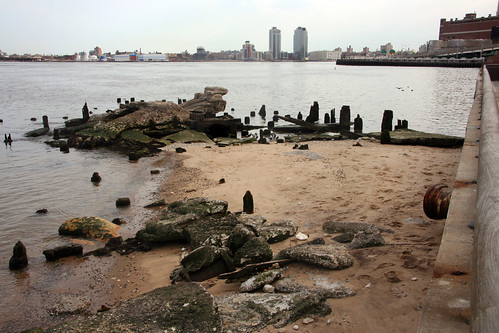
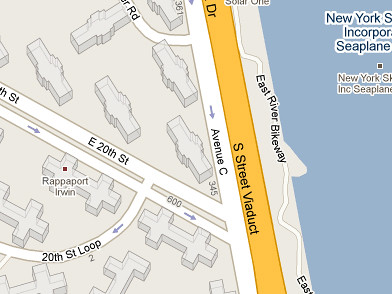





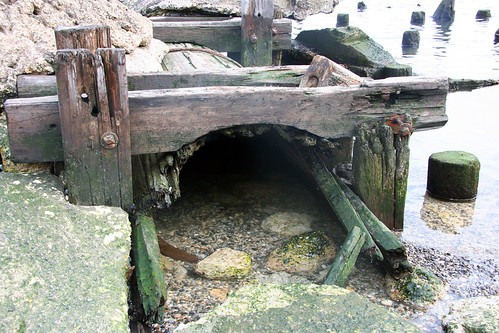
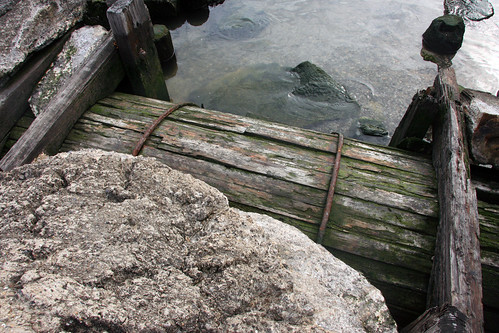
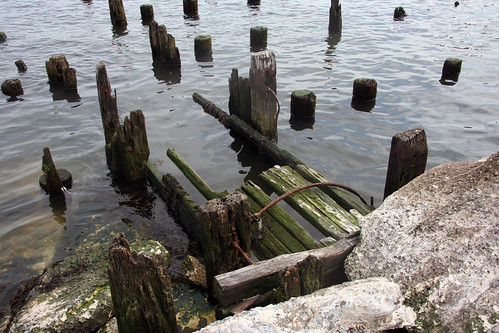
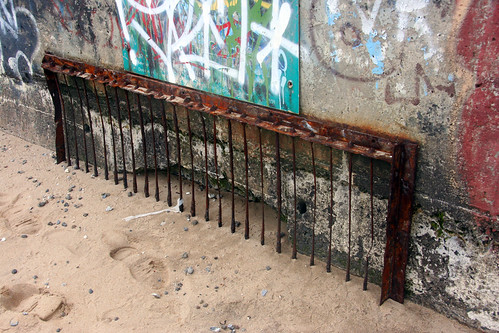
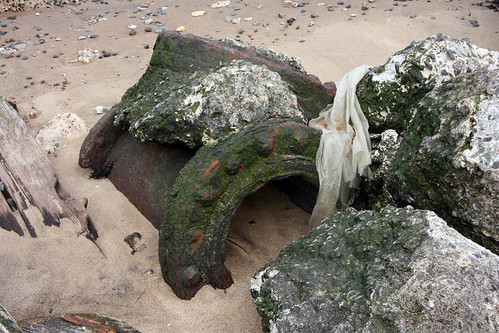


When my friends and I were in school we used to visit that bikeway and on at least one occasion two of us went down, on a dare, to the beach. It’s not the easiest thing to climb down on to inconspicuously. We had noticed the wood pipe, but didn’t think much of it at the time, we figured it was somehow part of the dock that used to be there. Regardless, I know if I search through my photos I have a picture of my friend dipping her toe into the river…I can’t say she felt too good after that.
Wooden pipes (or something representing them) can still be found all around the city. It seems the underachiever Alexander Hamilton took time out from creating the US Treasury Department and started a bank (and newspapers, etc). He and his new bank also invested in a new sewage system composed of something like four interlocking pieces of wood. Two centuries later his pipes are gone, but his bank lives on after mergers as Chase. And it’s ubiquitous logo is Hamilton’s wooden pipe. Or so I’ve read
Not Hamilton (who started the Bank of NY) but rather his nemesis and murderer Aaron Burr. The water company was a ruse to get a corporation chartered in order to form a bank (his real goal).
“CHELAN, Wash. — It has been 2,000 years since the Romans built their aqueducts, and 200 years since Philadelphia began using cast-iron water mains. But the 6-inch-wide city pipe that still delivers drinking water to a block on Nixon Street here uses an even more primitive technology: wood.”
http://www.nytimes.com/2009/04/18/us/18water.html
As for New York?
“Construction Find
During excavation of the site, two sections of wooden water pipes from the early 19th century were unearthed. Long pipe sections like those discovered—13 feet long and 14 inches in diameter, in good natural condition, with joints intact—have never before been preserved. According to JP Morgan Chase archival materials, the pipes found at Coenties Slip were laid circa 1808.
The Manhattan Company—today known as JP Morgan Chase—was a water supplier in the late 1700s that laid a network of log distribution pipes downtown. Over the past two centuries, much of the pipe system has rotted away or been discarded. The discovery of these pipes, part of the City’s oldest surviving infrastructure, is a rare and important historical find.
Parks & Recreation has been working with the Department of Environmental Projection, historians and conservators to preserve and ultimately find an arena where the pipes can publicly exhibited.”
http://www.renewnyc.com/displaynews.aspx?newsid=4cd3c183-3fa5-4f0d-aacc-e0804d068e43
first of all, the beach is not nameless–it’s called stuyvesant cove: http://www.newyorkharborbeaches.org/beach25.htm
second of all, the water’s not filthy and people need to stop assuming that it is. unless it’s rained a lot the night before, the east river is completely swimmable. join me and several hundred others for the brooklyn bridge swim in september. it’s only 800 yards, water temp 75, no one has yet died or gotten sick.
@Walter, the logo for Chase bank was created in 1961 by Chermayeff & Geismar. Alexander Hamilton founded the Bank of New York (not Chase or Manhattan). Aaron Burr founded the Manhattan Company, which is the oldest bank JPMorgan Chase can trace its history back to.
Last May I did the Great Saunter, which is a 32-mile walk around the perimeter of Manhattan. Saw a LOT of beaches!
Pingback: Special Olympics NY Will Be Honored In Albany
Pingback: Special Olympics NY Will Be Honored In Albany
That wooden pipe looks much newer. I expect it dates from the same time as the pier (which you could probably figure out from how long it would take those machine-made bolts and hoops to rust away). A bunch of the old wooden water-supply pipe was dug up in the 40s and 50s and cut up into ashtray bases; I wonder how many of those are still around. (My grandfather made the ashtray inserts.)
Great article!!! I run along the River all the time – and pass that little “beach” but never thought to look into it. Thanks for sharing!
Pingback: A beach in Manhattan? « Luciane Serifovic – Citi Relocation's Blog
There is a great beach in Inwood section of Washington Heights. I saw it 25 years ago. I hope it is still there. Anyone know(hsbb@sbcglobal.net)contact me
Pingback: Williamsburg’s Secret Beach « Scouting NY
I would pass this driving by on the FDR Drive. It is near Stuyvesant Town which is an apartment complex.
Pingback: Manhattan’s East Side waterfront gets some kayaks | City Atlas
robot cuisine
Feel free to visit my homepage: robot philips (http://www.egazing.biz)